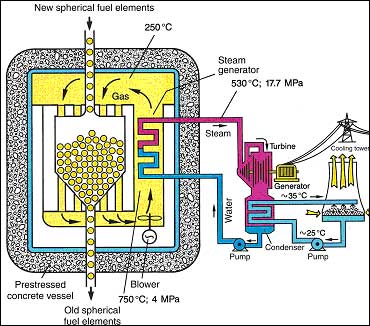******************************Excerpt********************



Many more images at the top link.
Posted on 11/08/2007 12:36:57 PM PST by Red Badger
Cape Town
United States based nuclear technology group Westinghouse Electric Company, a group company of Toshiba Corporation, has bought the South African firm IST Nuclear.
Westinghouse opened its newly acquired South African operation on Monday under the name Westinghouse Electric South Africa. The value of the transaction has not been disclosed, reports Southafrica.info.
IST Nuclear is a leading provider of services and systems for South Africa's Pebble Bed Modular Reactor (PBMR) project.
"Westinghouse has long been a proponent of the PBMR, and this acquisition will allow us to become even more involved as PBMR moves toward commercialisation," Nick Liparulo, Vice-President of engineering services for Westinghouse, said in a statement.
At the same time, Westinghouse views South Africa as a promising market for its particular brand of nuclear power plant, a third-generation pressurised water reactor system known as the AP1000.
In September, state-owned power supplier Eskom said it had short-listed Westinghouse, along with French nuclear giant Areva, as potential builders of South Africa's second nuclear power plant.
According to Engineering News, Eskom has set 30 June 2015 as the date by which it wants to have its first new nuclear reactor up and running by. The state supplier has indicated that it is looking to build as many as five new nuclear power stations by 2025.
Rita Bowser, Westinghouse's regional Vice President for South Africa, said the IST Nuclear acquisition illustrated Westinghouse's commitment to the South African nuclear market.
"The ability to work with a respected local company will allow Westinghouse to better serve this important market both now and in the future.
"Clearly, we are even better positioned to help South Africa meet the critical demand for clean, safe and reliable energy in the coming decades," Mr Bower said.
IST Nuclear was instrumental in the early development of the Pebble Bed Modular Reactor, working with Eskom and US-based investors including Westinghouse.
More recently, IST Nuclear supplied a helium test facility for the PBMR. The company is also under contract to design key systems for a PBMR demonstration unit to be built at Koeberg, South Africa's only nuclear plant, by 2011.
Westinghouse supplies nuclear plant products and technologies to utilities around the world.
According to the company, its technology is the basis for approximately one-half of the world's operating nuclear plants, including 60 percent of those in the U.S.
Pebble Bed Reactor Ping!............
I want one!
PBMR, in my opinion, is the nuclear power plant of the future. Safe, easy to operate, and it degrades beautifully.
I’m trying to convince people where I live that a PBMR would be the perfect solution to fluctuating energy prices.
******************************Excerpt********************



Many more images at the top link.
B> Department of Nuclear Engineering
********************EXCERPT*******************
Work continues on the development of the modular pebble bed reactor. Professor Ballinger continued his work on microsphere fuel performance modeling. Professor Kadak worked on two areas: safety analysis using a state-of-the-art computational fluid dynamics code incorporating complex chemistry to study graphite corrosion; and advanced modularity techniques to revolutionize how nuclear plants are built to reduce construction time and cost and improve overall product quality. The first two projects are supported by the Nuclear Regulatory Commission and the third is supported, once again, by NERI.
 The HRT-10 Pebble Bed Reactor in China first achieved a self-sustaining nuclear reaction in December 2000 and was synchronized to the electric grid in January 2003. It is a research reactor capable of producing 4 megawatts of power. |
The fuel performance modeling is expected to be used to design and—working with a manufacturer—optimize the performance of new advanced fuel particles for use in high-temperature reactors. The air ingress modeling is presently being benchmarked against tests and will ultimately be used to understand the details of the chemical reactions under accident conditions in a full-sized pebble bed or prismatic high-temperature reactor. The modularity work will identify how such a concept can be used to design and build small reactors. The modularity approaches have been compared with the construction of nuclear submarines at both Newport News Shipyard and the General Dynamics Shipyard in Quonset Point, Rhode Island. Based on these site visits and consultations, the approach being proposed appears quite practical and viable.
You’d better be prepared for all the insane questions the idiots will throw at you, ie, waste, radiation leakage, environmental controls, etc.........Just mention the word “nuclear” and they go off the deep end................
Who cares about those fools, anyway? Ignore them and get the reactors into production!
Importantly, both SA and Japan have produced *small* nuclear reactors. This technology is vital for everything from emergency energy supply, very isolated energy supply, and the space program.
One of its major design features is that it neither produces dangerous waste products like plutonium, nor can it easily be disassembled to remove its nuclear fuel. A process described as being close to “having to split the entire reactor in half.”
Disclaimer: Opinions posted on Free Republic are those of the individual posters and do not necessarily represent the opinion of Free Republic or its management. All materials posted herein are protected by copyright law and the exemption for fair use of copyrighted works.